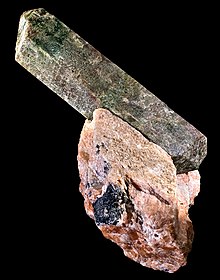
Back Apatiet Afrikaans Apatito AN أباتيت Arabic Apatit Azerbaijani Апатыт Byelorussian Апатыт BE-X-OLD Апатит Bulgarian Apatit BS Apatita Catalan Apatit Czech
| Apatite group | |
|---|---|
 Apatite (CaF) (fluorapatite) doubly-terminated crystal in calcite | |
| General | |
| Category | Phosphate mineral |
| Formula (repeating unit) | Ca5(PO4)3(F,Cl,OH) |
| IMA symbol | Ap[1] |
| Strunz classification | 8.BN.05 |
| Crystal system | Hexagonal |
| Crystal class | Dipyramidal (6/m) (same H-M symbol)[2] |
| Space group | P63/m (no. 176) |
| Identification | |
| Color | Transparent to translucent, usually green, less often colorless, yellow, blue to violet, pink, brown.[3] |
| Crystal habit | Tabular, prismatic crystals, massive, compact or granular |
| Cleavage | [0001] indistinct, [1010] indistinct[2] |
| Fracture | Conchoidal to uneven[3] |
| Mohs scale hardness | 5[3] (defining mineral) |
| Luster | Vitreous[3] to subresinous |
| Streak | White |
| Diaphaneity | Transparent to translucent[2] |
| Specific gravity | 3.16–3.22[2] |
| Polish luster | Vitreous[3] |
| Optical properties | Double refractive, uniaxial negative[3] |
| Refractive index | 1.634–1.638 (+0.012, −0.006)[3] |
| Birefringence | 0.002–0.008[3] |
| Pleochroism | Blue stones – strong, blue and yellow to colorless. Other colors are weak to very weak.[3] |
| Dispersion | 0.013[3] |
| Ultraviolet fluorescence | Yellow stones – purplish-pink, which is stronger in long wave; blue stones – blue to light-blue in both long and short wave; green stones – greenish-yellow, which is stronger in long wave; violet stones – greenish-yellow in long wave, light-purple in short wave.[3] |
Apatite is a group of phosphate minerals, usually hydroxyapatite, fluorapatite and chlorapatite, with high concentrations of OH−, F− and Cl− ion, respectively, in the crystal. The formula of the admixture of the three most common endmembers is written as Ca10(PO4)6(OH,F,Cl)2, and the crystal unit cell formulae of the individual minerals are written as Ca10(PO4)6(OH)2, Ca10(PO4)6F2 and Ca10(PO4)6Cl2.
The mineral was named apatite by the German geologist Abraham Gottlob Werner in 1786,[4] although the specific mineral he had described was reclassified as fluorapatite in 1860 by the German mineralogist Karl Friedrich August Rammelsberg. Apatite is often mistaken for other minerals. This tendency is reflected in the mineral's name, which is derived from the Greek word ἀπατάω (apatáō), which means to deceive.[5][6]
- ^ Warr, L.N. (2021). "IMA–CNMNC approved mineral symbols". Mineralogical Magazine. 85 (3): 291–320. Bibcode:2021MinM...85..291W. doi:10.1180/mgm.2021.43. S2CID 235729616.
- ^ a b c d Apatite. Webmineral
- ^ a b c d e f g h i j k Gemological Institute of America, GIA Gem Reference Guide 1995, ISBN 0-87311-019-6
- ^ According to Werner himself – (Werner, 1788), p. 85 – the name "apatite" first appeared in print in:
- Gerhard, C.A., Grundriss des Mineral-systems [Outline of the system of minerals] (Berlin, (Germany): Christian Friedrich Himburg, 1786), p. 281. From p. 281: "Von einigen noch nicht genau bestimmten und ganz neu entdeckten Mineralien. Ich rechne hierzu folgende drei Körper: 1. Den Apatit des Herrn Werners. … "(On some still not precisely determined and quite recently discovered minerals. I count among these the following three substances: 1. the apatite of Mr. Werner. … )
- Werner, A.G. (1788) "Geschichte, Karakteristik, und kurze chemische Untersuchung des Apatits" (History, characteristics, and brief chemical investigation of apatite), Bergmännisches Journal (Miners' Journal), vol. 1, pp. 76–96. On pp. 84–85, Werner explained that because mineralogists had repeatedly misclassified it (e.g., as aquamarine), he gave apatite the name of "deceiver": "Ich wies hierauf diesem Foßile, als einer eigenen Gattung, sogleich eine Stelle in dem Kalkgeschlechte an; und ertheilte ihm, – weil es bisher alle Mineralogen in seiner Bestimmung irre geführt hatte, – den Namen Apatit, den ich von dem griechischen Worte απατάω (decipio) bildete, und welcher so viel as Trügling sagt." (I then immediately assigned to this fossil [i.e., material obtained from underground], as a separate type, a place in the lime lineage; and conferred on it – because it had previously led astray all mineralogists in its classification – the name "apatite", which I formed from the Greek word απατάω [apatáō] (I deceive) and which says as much as [the word] "deceiver".)
- ^ "ἀπατάω". Logeion. Archived from the original on Feb 22, 2023. Retrieved Feb 22, 2023.
- ^ "Fluorapatite mineral information and data". mindat.org. Retrieved 30 January 2018.